Resurrecting a war memorial
Author: Dr Paula Furby
{1} On 18 May 2001, fifty years after its original dedication, the Adelaide Teachers College War Memorial was rededicated in the Barr Smith Library at the University of Adelaide. In unveiling a plaque, John Bailey (State President of the Returned & Services League of Australia) praised the memorial as an example of a living memorial, among others like hospitals or gardens, which give service or pleasure to generations of people. His praise was generous, for this living memorial had lapsed into obscurity; hence the need for rededication. The event was sponsored by the Department of Veterans’ Affairs through the "Their Service Our Heritage" program.
{2} The Adelaide Teachers College War Memorial is surely unique in several ways. Consisting of a plaque, a roll of honour and an art collection, it honours the war service of a profession: the teaching profession. The impetus for the memorial came from students at Adelaide Teachers College in Kintore Avenue, in the early years after World War II. Many were ex-servicemen and women.
{3} The aim of creating a memorial and its possible form was debated, from 1946 to 1948, by students who were determined to avoid a conventional, dust-collecting memorial.1 They wanted something practical instead. One proposal was for an annual book prize, with the idea that the publication of its conditions and award ceremony would result in a perennial remembrance of those who served and those who died, as well as helping the living. There was disagreement, however, as to whether books should be awarded to students or lodged in the library.
{4} At the same time, students knew of Melbourne Teachers College’s excellent collection of contemporary art and had intended starting a collection of their own. Merging the idea of a memorial with the desired art collection provided a solution to the impasse. It was resolved to create a war memorial art fund and begin collecting original paintings by established contemporary Australian artists "of fitting quality". In 1948 the students altered their constitution to establish the fund, and from 1949 to 1961 levied each student two shillings per year for the purpose. Teachers also donated funds in 1950. The intention was to collect works over a twenty-year period until the College’s assembly hall was suitably decorated with pictures.
{5} Though collecting continued into the early 1960s, the Memorial was actually dedicated at a ceremony in the College (now the Hartley Building of the University of Adelaide) on 18 May 1951. Pictures and a plaque were hung in the assembly hall. The plaque stated: "The pictures in this hall are a Memorial to the Men and Women of this College who served in World War II 1939-1945."2 In 1952 a roll of honour was added to the Memorial. It is a hand-made book containing the names of five hundred and twenty two men and women with war service who had attended the College. It was elegantly printed, illustrated and bound by Christopher Burfield, and contains six linocuts representing aspects of war.
{6} During the original student debate on the nature of the Memorial, the durability of an art collection and the College itself was not considered. In 1961 renovations to the College building began, and the beautiful two-storey assembly hall was rendered unsuitable for housing the Memorial. The works were dispersed to other parts of the building and to College annexes for safekeeping. As a result the Collection’s purpose and role was compromised. Over the decades, many works became misplaced and lost, a process exacerbated by several institutional reorganizations across the Adelaide tertiary sector. The Memorial’s plaque disappeared, possibly as building waste.
{7} In 1990, when the City Campus of the South Australian College of Advanced Education merged with the University of Adelaide, the War Memorial Collection was allocated to the University. Unfortunately, by then only half the works could be located for formal acquisition. These remaining works were shown in 1992 in the Barr Smith Library in an exhibition initiated by the University Works of Art Committee.3 The exhibition brought the Collection to the attention of Adelaide Teachers College ex-students, who remembered its foundation and significance. They formed a committee to work towards the preservation and rededication of the Memorial. One member, Bill Marsh, was inspired to research and write its history.4
{8} The committee members have been passionate in their task of reconstituting and rededicating the Memorial. Their passion is bound up with and reflects what is unusual about the Memorial: its links to a profession, and its ideals of service. The founders of the Memorial made no distinction between the two aspects, service in war and service in the teaching profession. Thus it is not only a memorial to those who served in the war, but also to those who serve as teachers. It takes an understanding of the idealism and difficult conditions of Australian teachers, particularly those in country service, to appreciate this nexus.
Artistic significance
{9} Aside from its symbolic importance as part of a war memorial, what is the significance of the collection artistically? With half the collection missing, this question provides a challenge. Certainly collecting was always eclectic, sometimes undertaken with professional advice and sometimes not. Originally, there was the published intention to select paintings by contemporary, yet established, Australian artists of "fitting quality". The sense of the works, when hung together, suggests that the "fitting quality" referred to the serious purpose of the Memorial. This quest for a certain quality may partly explain why works by beginners and established artists were collected, contrary to policy.
{10} The collection reflects well-known currents in Australian art history over the fifteen-year period of purchasing. It is not surprising, for example, that this unusual concept linking contemporary art and a war memorial arose in Adelaide Teachers College. The organized contemporary art movement in South Australia was initiated by school art teachers such as Shirley Adams, Victor Adolfsson, David Dallwitz, Ivor Francis, Jacqueline Hick, Douglas Roberts and Jeffrey Smart in 1942 when they held their radical exhibition First Exposition Royal SA Society of Arts Associate Contemporary Group. These teachers and other artists went on to build a strong contemporary art movement in Adelaide, within the Contemporary Art Society and also within the Royal South Australian Society of Arts. Some participated in the 1942-43 Anti-Fascist Exhibition and the 1945 Australia at War Exhibition.
{11} Collecting for the War Memorial began in 1949 by a small committee. Comprising two staff members and two students, it was responsible to the Student Representative Council to acquire, arrange and display suitable works. By 1949 the contemporary movement in Adelaide was in flux, with younger leaders and a new multicultural direction from migrant artists.5 The collections committee was unable to locate suitable works in Adelaide, aside from a watercolour by Blamire Young. Two student members, John Bailey and Kingsley Fletcher, went to Melbourne and, acting upon advice from Professor Joseph Bourke of the Fine Arts Department of Melbourne University and Mrs O’Grady of Melbourne Teachers College, purchased seven paintings. They were the nucleus of the Collection. Five have been identified: four landscapes and one flower painting by Arnold Shore titled Zinnias.
{12} Early in 1950 the committee purchased two works by ex-students of the College, namely Jacqueline Hick and Geoffrey Wilson, and another by John Bailey, a final year student. When the dedication of the Memorial took place in 1951, the Collection comprised twelve pictures and a cast bronze plaque by the sculptor Joseph Choate, also an ex-student of the College. Choate at that time was President of the Contemporary Art Society. Later in 1951, a major work by Arthur Boyd was acquired, Eroded creek bed, from his Wimmera Landscapes Series. This painting was purchased directly from the artist’s studio and hung centrally in the assembly hall, above the plaque and roll of honour.
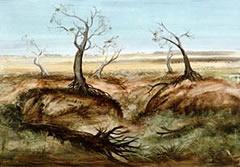
Arthur Boyd, Eroded creek bed, c.1951, oil and tempera on board, 87.0 x 122.5 cm
{13} By 1952 up to twenty pictures had been collected, most from local contemporary artists exhibiting with the Contemporary Art Society, Royal South Australian Society of Arts, or John Martin’s Art Gallery. There was an hiatus in collecting in the mid-1950s, when ex-service men and women had completed their studies and the collections committees met infrequently. It recommenced in earnest in 1960. A decision to use accumulated funds and finalize collecting coincided with a flowering of Australian painting and printmaking in the 1960s. Selection was facilitated by the new Adelaide Festival of Arts, which inspired interstate artists to exhibit in Adelaide. Approximately twenty works were acquired in the early 1960s, many chosen from Festival exhibitions. Overall, thirty-nine works may have been purchased for the War Memorial Collection by the time its fund was depleted in the mid-1960s. However a list of thirty-six works, prepared by Adelaide Teachers College in about 1966, has since been recognized as the definitive War Memorial Collection.
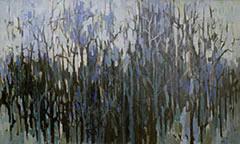
John Dallwitz, Trees, 1960, oil on composition board, 121.0 x 200.0 cm
{14} The thirty-six works comprise thirteen oil paintings, ten watercolour paintings and thirteen prints. Some were considered significant at the time of purchase. In 1951, for example, four works were loaned to the Jubilee Art Exhibition, where they were judged best in the show by the conservative art critic Esmond George. Another, Douglas Roberts’ Bushfire fringe, came second in the 1960 Caltex Prize for a South Australian or Northern Territory landscape. Trees by John Dallwitz, a student at Western Teachers College, was seen as evidence of that young artist’s promise.
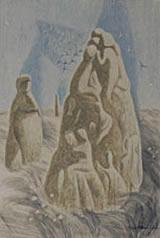
Eric Thake, The mound of whispering children, 1949, watercolour on paper, 46.0 x 32.0 cm
{15} Two works were controversial when purchased. One, a surrealist watercolour by Eric Thake titled The mound of whispering children, provoked debate among student teachers in 1949, with arguments for and against it published in their magazine The torch. Yet it is a fine example of Thake’s art, and directly arises from his work as a war artist in Northern Australia. The other, David Boyd’s Buckley reclaimed, from his Explorers Series, was highly controversial among art critics when painted because of the Series’ literariness, a quality that is not a problem today. It was a courageous purchase, and given its subject matter – the exploration of Aboriginal/European history – is still an important painting. By contrast, Arthur Boyd’s Eroded creek bed was never controversial, though it engages in social comment, too, as it records environmental damage.
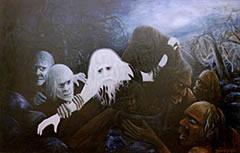
David Boyd, Buckley reclaimed, 1957-58, oil on composition board, 134.5 x 211.0 cm
{16} The Collection includes beautiful watercolours such as Geoffrey Wilson’s River, towards Port Noarlunga, which was praised by Lisette Kohlhagen when first exhibited in 1950.6 Other fine watercolours are Donald Friend’s superb Herd of deer and Len Annois’ Aries Beach.
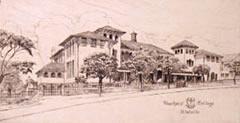
Alan Sierp, Adelaide Teachers College, 1937, etching, 16.5 x 31.5 cm
{17} Although the Collection was originally intended to comprise paintings, significant prints were included from the beginning. Early purchases were prints by Jacqueline Hick and Christine Miller, artists who were outstanding experimental printmakers in Adelaide in the 1940s.7 Others include a linocut by Dorrit Black, who was an initiator of modern art in Adelaide and mentor to young contemporary artists, and another by Charles Bannon called Entrance to a city. Later, in the 1960s, when printmaking in Australia was flourishing, the War Memorial selection committee bought well, adding works by Noel Counihan, Mary Macqueen, Barbara Brash and Robert Grieve.
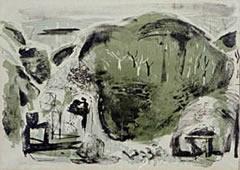
Mary Macqueen, Crater country, lithograph, 37.6 x 53.4 cm
The missing pictures
{18} The absence of almost half the works in the War Memorial Collection is, at a symbolic level, a matter of deep regret to old scholars. Visually and aesthetically, their absence continues a state of affairs which existed from the mid-1960s after purchasing ceased. Once works were dispersed for safekeeping during renovations, it is unlikely that the completed collection had ever been seen as a whole. By 1974, when a stocktake occurred, works were already missing.
{19} If the complete Collection could magically reappear, it would indicate that there was an aesthetic plan behind the selection. It was there in the phrase "fitting quality", and surely developed as the pictures were hung to decorate the beautiful College assembly hall. The Collection overall has a cool tonality, which would have contributed to a reflective atmosphere, suitable to its purpose. Further and unsurprisingly, there is a serious didactic element. This is present in works of social comment already mentioned, and notably in Alma Gross’ painting Starving children and Noel Counihan’s trenchant linocut Memory of Italy.
{20} Pictures were hung along the wainscotted walls of the hall, on the west and eastern sides, and interspersed with windows on the western side’s mezzanine walk above. One painting was hung on the southern wall, which was the Memorial’s focal point. Apparently, paintings were not hung at the northern end of the hall where a stage was located. The students sought over many years, and eventually found, a big picture for the central location of the Memorial, above the plaque and roll of honour, to replace the Arthur Boyd painting which was not big enough. When that was achieved, with the purchase of Buckley reclaimed, collecting activity was wound up. We can now only imagine the site-specific Memorial, however it is said that the effect in the late afternoon of sunlight shining from the mezzanine windows onto the central painting was absolutely striking.8
Strength and weakness of the Memorial
{21} Adelaide Teachers College War Memorial came close to failing its planned role. Its near-failure was due to its function as a living memorial rather than durable stone or metal. Though its founders feared establishing a monument to gather dust, their memorial of pictures gathered dust once the pieces were dispersed and their function lost. Many are minor works, so that the collection as a whole is greater than the parts. The problem was that an art collection requires a continuing commitment to survive as a coherent living entity.
{22} Now, the War Memorial Collection is more secure, as a result of the passionate commitment of ex-students who worked towards its rededication and the curatorship of the University of Adelaide. Regret continues that so many works have disappeared, but that regret could be turned to a positive end. Substitute paintings or identical prints by the original artists could be acquired. Another initiative might be to have an annual remembrance ceremony, or the annual purchase of a new work to encourage today’s young artists. Meanwhile, the unexpected can happen. Publicity for the rededication has resulted in two missing works being located. More may reappear. A list of the missing works appears below.
{23} The Collection is currently on view to the public in the foyer of the Waite Building, Urrbrae, until January 2002. The new plaque will be permanently installed in the Hartley Building and the roll of honour can be seen in Special Collections at the University of Adelaide Barr Smith Library. The Adelaide Teachers College War Memorial is an unusual part of South Australia’s heritage. Its history demonstrates that we cannot take heritage for granted.
List of missing works
- John Bailey, Burnt Yaccas, c.1950, gouache on cardboard, 43 x 61 cm
- Charles Bannon, Entrance to a city, c.1952, linocut
- Ray Bizley, Ancient structure, [print]
- Dorrit Black, a street scene, possibly Elizabeth Street, Sydney, linocut
- Barbara Brash, Peacock, [print]
- Malcolm Carbins, Barula Road landscape, oil
- Nancy Clifton, Bodgies, linocut, 38.5 x 22
- Robert Grieve, Owl, [print]
- Robert Johnson, Osbornes Flat, Yackandandah, oil
- Christine Miller, The dance of death, etching
- Mary Milton, Mountains, oil
- J.N. Arthur Rouse, Tower Bridge, [print]
- Harry Sennett, Landscape, oil
- Arnold Shore, Zinnias, oil
- Raymond Williams, Creek scene, oil
- Blamire Young, Lake Corot, watercolour
© Dr Paula Furby
The author
Dr Paula Furby is an art historian who is currently Visiting Scholar in the Women’s Studies Department at Flinders University. She is a member of the University of Adelaide Works of Art Committee and has published on the university’s art collection.
Notes
1 Adelaide Teachers College, 39th Annual Report, p.4.
2 The Advertiser, 19 May 1951, p.2.
3 Works of Art from the University of Adelaide Collections: The War Memorial Collection, Barr Smith Library, 19 February to 22 March 1992.
4 William C. Marsh, Adelaide Teachers College War Memorial, Adelaide 2001; copy held in Mortlock Library.
5 As evidenced by the exhibition South Australian Contemporary Art Society 7th Annual Exhibition, RSASA Gallery, 4-13 July 1949.
6 Lisette Kohlhagen, Advertiser, April 1950.
7 Alison Carroll, Graven Images in the Promised Land: A History of Printmaking in South Australia 1836-1981 (Adelaide: Art Gallery of South Australia, 1981).
8 Bill Marsh, conversation with the author, June 2001.